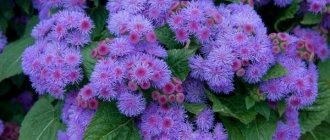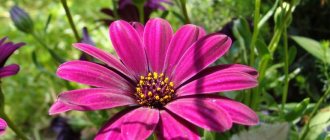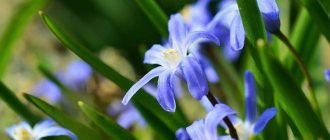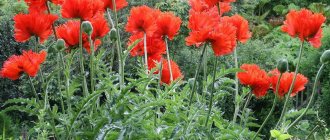Houston's ageratum (lat. Ageratum houstonianum) is one of the most popular ornamental plants. It belongs to the Asteraceae (Asteraceae) family and grows up to 80 cm in height. Its homeland is Mexico, as well as tropical regions of Central and South America. Due to the long flowering period from May until the first frost in the fall, this plant is very popular with many amateur gardeners as a border for flower beds, for pots and balcony boxes, and also for decorating a grave. Its dense flowers in blue, pink, purple or white shine from afar and form velvety flower cushions with a charm all their own.
Despite the fact that Houston's ageratum requires little care, with the right approach, successfully growing this plant in your garden is not difficult even for beginners in the field of floriculture.
First steps after purchase
After acquiring Ageratum seedlings or cuttings, the plant needs to be transplanted into a suitable pot. A spacious and voluminous container is suitable, since the young plant quickly gains root mass.
At the bottom you need to lay a thick layer of drainage made of expanded clay, perlite or crushed bricks. The plant is not picky about the composition of the soil. A universal soil mixture or soil from a garden plot will do. The main thing is that the soil has a neutral reaction.
Ageratum seedlings
Ageratum is transplanted together with a ball of earth, which minimizes the risk of injury to the roots. After transfer, the remaining part of the pot is filled with soil and watered generously.
Popular types and varieties of ageratum
Creeping tenacious (Ajuga Reptans) - planting and growing from seeds
There are more than 60 species of longflower and each of them has its own unique beauty. In garden stores you can find a variety to suit your taste, but several types of ageratum are especially popular.
Ageratum Blue Mink
An ornamental plant of small stature - reaches a height of no more than 35 cm.
Blue Mink
It is distinguished by thin, lint-like petals that resemble mink fur in appearance (hence the name of the variety). This type is used for decorative decoration of flower beds or creating living borders.
Blue mink is a heat-loving plant; in the Russian climate it is grown as an annual. The flowers are tubular in shape and collected in inflorescences up to 25 cm in diameter.
Ageratum Houston (or Gauston)
Also known as Mexican Blue Ageratum.
Ageratum Houston
A distinctive feature of this species is the ability to maintain the decorative appearance of inflorescences for a long time. In suitable conditions it is a perennial. Can reach a height of 50 cm.
The flowers have a pronounced aroma, are small in size, and form baskets with a diameter of 1 cm. The baskets, in turn, form inflorescences with a diameter of up to 10 cm.
Ageratum Summer Snow
Summer Snow
In Russia it is better known as the “white ball”. It is a dense bush that can grow up to 45 cm.
Its inflorescences grow up to 2 cm in diameter and become voluminous. Thanks to this, as well as abundant flowering, adult ageratums look like lush white balls.
For reference! Although Summer Snow originally grew as a perennial, in colder climates it is planted as an annual.
In addition to these, many other varieties are known: ageratum Bonjour, Red Bouquet, Inca Gold, Pink Ball and many others. The choice of plant depends primarily on the climate in which it will live and the purposes for which it is grown.
Basic care parameters
Ageratum is not a demanding species. However, plants need systematic attention and care. If the recommendations are not followed, flowering will be sparse or completely absent.
- Air temperature and humidity. Ageratum is thermophilic. The air humidity parameter is not important for it; ordinary room air is suitable.
- Lighting should be bright. A little shade is allowed, full shade is destructive.
- Watering is moderate, as the top layer of soil dries. However, when water stagnates in the pot, the risk of root rot or blackleg increases.
- Soil parameters - optimal use of light, drained soil with a neutral reaction. A shift to the acid side is undesirable.
- Pruning – sanitary and formative pruning is necessary throughout the life of the plant. Weakened and broken shoots and dried flowers must be removed.
- The dormant period occurs in winter. Plants should be moved to a cool place (+17-19 degrees) and watering should be reduced.
- Flowering is extended over time. During this period, the plant needs little fertilizer, bright lighting and maintaining soil moisture.
- Feeding is carried out once every 2-3 weeks. Nitrogen compounds are used to increase green mass, and potassium-phosphorus compounds are used to stimulate flowering.
- Replanting is required as the pot fills with the root system. It is possible to use the method of transshipment or cleaning of roots.
Reproduction
Ageratum is most often propagated by seeds. They are sown in open ground in May or for seedlings in March. In the second case, it will begin to bloom in June.
Ageratum seeds are very small, so they are not sprinkled with soil at all. The seedling box is filled with a light nutrient substrate.
It may contain peat, sand, humus, vermiculite, and turf soil. The mixture is moistened and planting material is sown.
The top of the box is covered with glass or polyethylene film to achieve a greenhouse effect. It is necessary to ventilate the seeds periodically and constantly monitor the moisture content of the substrate.
The box should be in a warm, bright place, then seedlings will form after 8-15 days. After seed germination, the film and glass are removed. Caring for sprouts consists of regular watering and application of mineral fertilizers with a break of 10-14 days.
A couple of weeks before planting in open ground, seedlings begin to harden off so that they can withstand changing climatic conditions well.
The seedlings need to be taken outside, each time increasing the residence time. If it is not possible to grow seedlings at home, you can sow the seeds directly in the front garden.
However, it is worth considering the fact that about 60-70 days pass from germination to flowering. Therefore, seeds should be sown in the third ten days of April.
In this case, Ageratum is planted in some containers and covered with lutrasil using arcs. The shelter can be removed no earlier than the third ten days of May, when there are no longer frosts.
Any sprouts must be pinched if you want to get lushly branched bushes. Pinching is usually carried out above the 3rd or 4th pair of true leaves.
Home care
Obtaining abundant, long-lasting flowering of Ageratum is associated with following certain recommendations. Following simple rules will ensure the growth and flowering of the plant for 4-6 years.
Choosing a location and lighting
Ageratum needs intense lighting. Some shade is allowed, but the plant does not grow well in full shade. Plants grown in the shade are characterized by thin, elongated shoots that are prone to kinking and infection.
The optimal place to install the pot is the south side. Cold drafts are detrimental to shrubs. Therefore, you should carefully monitor the temperature.
Soil selection
The mechanochemical composition of the soil must include good drainage. Stagnation of water in the pot leads to the spread of rot and death of the plant. An acidic soil reaction is unacceptable. With increased acidity, the root system will be injured and become susceptible to infection.
The main condition for abundant flowering is the use of light, depleted soils. The use of nutrient soils slows down the flowering process.
Temperature and humidity
Ageratum grows well in the temperature range of +18-25 degrees. Being a heat-loving plant, it does not tolerate frost well. When the temperature drops below +18, the process of withering begins.
Ageratum is undemanding in terms of humidity. Regular room air is fine. But when the heating season begins, plants will need to be sprayed every 3-4 days.
Proper watering
Watering is carried out with warm, settled water. Using cold water inhibits root activity. Young plants need regular watering as the top 2 cm of soil dries out. Mature plants can tolerate short-term drought. However, long dry periods lead to reduced flowering.
Watering should be done in the morning, while trying not to get water on the leaves. After each watering it is necessary to loosen the soil.
Trimming
It is necessary to regularly remove faded inflorescences to maintain decorativeness. Removing broken and weak shoots leads to longer flowering and an increase in the number of inflorescences. Haircut has a stimulating effect on plant growth. To create a lush crown, pinching of young shoots is required. The method allows you to obtain additional branching and the formation of flower buds.
Faded inflorescences must be removed
Fertilizer application
Fertilizers are required to obtain abundant flowering. Complex fertilizers for flowering plants are suitable. They need to be applied every 14-21 days. The use of concentrated or organic fertilizers is prohibited.
When using nitrogenous fertilizers, it is recommended to apply a lower dosage, since excess leads to the growth of green mass and delays flowering.
Potassium-phosphorus supplements are required to stimulate budding.
Bloom
Ageratum blooms for several months, so one bush will have wilted and blossoming inflorescences. Dead flowers must be cut off if they are not planned to be used for seed production. Otherwise, leaving dried flowers will spoil the decorative appearance.
To obtain rich flowering, a sufficient level of light is required. In the shade, flowering is rare or completely absent. The plant blooms poorly in heavy soil. Therefore, you should maintain the soil in a loose state, monitoring the level of moisture.
Transfer
Replanting is required when the roots fill the volume of the pot or the plant is damaged by pests. 2 methods are used:
- Handling while preserving the earthen clod is for transferring a healthy plant.
- Cleaning the roots - for transporting a sick or pest-infested specimen.
Growing Ageratum
Longflower is a heat-loving plant. Ageratum flowers are small, collected in inflorescences. The pistils protruding above them add a special charm. A plant covered with such fluffy balls looks very unusual and bright. The question of whether ageratum is a perennial or an annual is difficult to answer. It can be both, and can sometimes reach the size of a small bush.
Ageratum can grow to a height of about 70 cm. The long-flowering plant blooms for a very long time - from the beginning of summer until the first cold weather. With proper care, seeds may appear in September.
Ageratum
There are two ways in which a flower can be grown. And if cuttings are used on an industrial scale, then germination from seeds is more suitable for amateurs.
Propagation by seeds is better than propagation by cuttings for several reasons:
- the plant will flower earlier, since when cuttings you have to wait longer for the sprouts;
- using the seed method, you can plant many different types and varieties of ageratum on your site;
- seeds are easy to purchase, as they are sold in any specialty store.
How to collect seeds for seedlings
Seeds for seedlings should be collected immediately after flowering. This usually occurs 15 days after the first flowers appear.
In order for seedlings to emerge from seeds, the plant must be pollinated. There should be no problems with this, since bees and wasps readily collect nectar from the ageratum.
Attention! If the plant is indoors, then it needs to be taken outside or to the balcony for pollination.
The seeds have an oblong shape, very small weight and size. Healthy seeds should be light brown in color. It is better to store them in paper or fabric bags until planting.
Seeds
Main problems
Despite the unpretentiousness of Ageratum, the following difficulties may arise when growing it:
• Why doesn't the plant bloom? The lack of flowering is due to lack of light. You should move the pot to a more illuminated place or install a phytolamp for additional lighting. Another reason for the lack of flowers is the acclimatization period. Young plants, especially after replanting, adapt to new conditions and their energies are directed towards growing the root system rather than flowering.
• Why do the leaves turn yellow and fall off? The change in leaf color is due to an incorrect temperature background. Too hot air leads to drying out and falling leaves. Relocating Ageratum to a cooler place and additional spraying from a spray bottle will help restore its decorative appearance. Another reason for yellow leaves is a lack of microelements. Fertilizer should be applied according to the manufacturer's instructions to restore balance.
• Why do flowers and leaves turn black? A change in the color of flowers to dark tones indicates the presence of a fungal infection. The spread of infection leads to blackening of leaves and shoots. Treatment for the problem is to immediately remove the damaged areas and thin out the shoots. Excessive thickening leads to disruption of air circulation and increased humidity inside the crown. High humidity is the optimal environment for fungal growth.
• Why did growth stop and the leaves turned lighter? The reason for the slowdown in growth is the process of acclimatization of Ageratum in a new pot. Treatment is to gradually harden the plant by placing it outdoors for a few minutes in calm weather. Another factor in slowing growth is low room temperature. The plant should be moved to a warmer place, monitoring the temperature.
Diseases and pests
The beauty of ageratum can be noticeably damaged by pests or diseases:
- Rot. The disease appears when the humidity of the environment or soil is high. Rot is characterized by the appearance of dark spots on the leaves. It is treated by spraying the plant with Fundazol or Topaz. If this does not help, then the infected bush is dug up and destroyed.
- Cucumber mosaic. Characterized by the appearance of yellow spots on the leaves. It is impossible to cure it, therefore, for preventive purposes, the soil is regularly weeded and weeds are removed. Since insects are carriers of the disease, when they first appear, it is necessary to take measures to destroy them.
Whitefly
- Whitefly. These insects are easy to spot on the leaves. Pests feed on the sap of the plant and if you do not take action, they can kill it. You can get rid of whiteflies using Actellik or Aktar.
By following the provided requirements for growing and caring for ageratum, you can get an unpretentious plant that will decorate your apartment or garden.
Landscape Design Ideas
Low-growing varieties look great framing borders and paths; in garden beds, in combination with bright marigolds and zinnias, they will create a wonderful, cozy tandem. They can also be planted on alpine hills among plants creeping along the ground; beautiful, lush balls will add brightness and chic to the hill.
Tall varieties can take their rightful place in the center of the flower bed, framed by lower flowers of various colors. They can be planted in large flowerpots next to hanging petunia; such compositions will perfectly decorate any corner of your yard.
If this lush beauty has not yet visited your flower garden, then be sure to plant it this year. Believe me, you will remain in love with this variety of colors forever, and on cold, winter evenings the memory of these rich colors will give you a little summer warmth.
The photo below shows just some of the beautiful flower beds in which landscape design ideas with Ageratum are embodied:
Before planting fruit trees, I choose successful “neighbors” for them in order to get a rich harvest and 100% survival rate
“I’m already preparing a bed for winter garlic” - I tell you what I do before planting in the fall in order to ensure a good harvest “I’m preparing a seasoning that will improve any dish” - I’m sharing a recipe for a simple, tasty and healthy garlic spice “Time to replant peonies” - I tell you when and how to do it correctly replanting peonies so that they bloom next year “The pepper in the garden turned black and disappeared”: I tell you what caused it and how you can save the harvest “Ugly and deformed tomatoes will not appear” - I tell you the reasons and how to eliminate them
Watering
cannot be flooded , so watering is done as needed. In hot weather - more often, in cold weather - less often. Ice water should not be used for irrigation, so as not to create stressful conditions for the developed root system.
Read with us about diseases of domestic violets.
Croton plant care will be easy with these helpful tips.
Find out more about indoor hydrangea https://sad-doma.net/houseplants/dekarativnotsvetushhie/gortenziya/uhod-gort.html and the features of caring for it.











